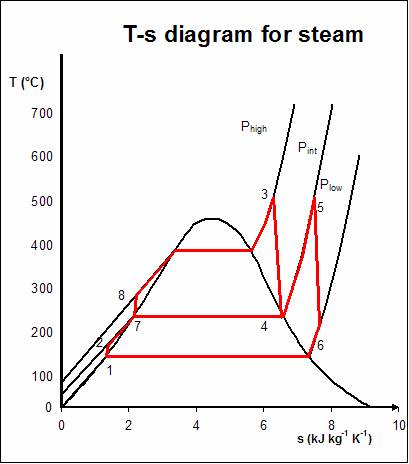

img src: http://www.siemens.com/innovation/apps/pof_microsite/_pof-spring-2013/_html_en/combined-cycle-power-plants.html
Improving Efficiency
Using multiple cycles together improve efficiency. By capturing thermal energy and reusing it requires less input energy, thus improving efficiency. There are multiple ways to improve the efficiency of each individual cycle as well to improve the system as well.
The thermal efficiency of a Rankine cycle can be increased by increasing the average temperature to which heat is added to the working fluid, and decreasing the temperature where heat is rejected. This can be seen as increasing Thot, and decreasing Tcold. Using the carnot efficiency as a baseline, you can see instantly that efficiency increases. Another way to increase the efficiency of this cycle is to use reheaters and regeneration. Referring to the T-S diagram located below, reheating is happening between stages 3 and 5. By allowing the working fluid to cool

down to an intermediate temperature in a high pressure turbine, and pumping the fluid back to the boiler to be reheated and sent to a low pressure boiler, the net work increases. That is the area enclosed by the power cycle on the T-S diagram. Regeneration is seen from stages 1,2,7,8 which use feedwater heaters to heat the working fluid from the cooled down fluid from the reheater on the way to the boiler. This reduces the work in to the system, also increasing net work.
The Brayton cycle can use several steps similiar to this to improve the efficiency of the topping cycle. Stages of intercoolers, reheaters, and regeneration can be used to capture as much energy that could have possibly been waste energy without these steps.
img src: http://en.wikipedia.org/wiki/File:Regenerative_rankine_cycle.jpg